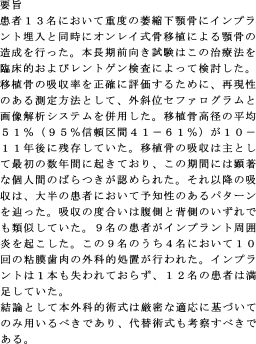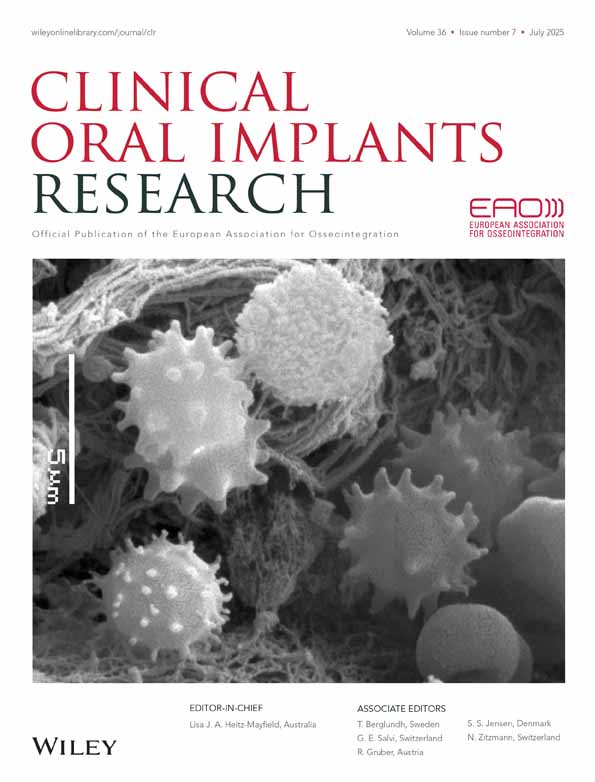Permucosal implants combined with iliac crest onlay grafts used in extreme atrophy of the mandible: long-term results of a prospective study
Abstract
enAbstract: Thirteen patients received an onlay bone-graft augmentation to their severely atrophic mandible in combination with simultaneous implant insertion. This treatment modality was studied in a long-term prospective clinical and radiographic study. A reproducible measurement method, consisting of oblique lateral cephalometric radiographs, in combination with an image analysis system, was used to accurately assess the graft resorption rate. On average, 51% (95% confidence interval 42–61%) of the grafted bone height remained after 10–11 years. Resorption of the graft occurred mainly during the first years and showed a marked degree of individual variance. In the following years, the resorption rate followed a predictable pattern in most of our patients. Ventral and dorsal sites exhibited a similar degree of resorption. Peri-implantitis occurred in nine patients. Ten muco-gingival surgical interventions were necessary in four of these nine patients. No implants were lost and 12 patients indicated that they were satisfied. It is concluded that the described surgical technique should be used on stringent indication only, and alternative techniques are discussed.
Résumé
frTreize patients ont subi un épaississement de greffe osseuse en onlay sur leur mandibule sévèrement atrophiée en association avec l'insertion simultanée d'implants. La modalité de traitement a étéétudiée dans une étude radiographique et clinique prospective à long terme. Les méthodes de mesure reproductibles consistant en des radiographies céphalométriques obliques latérales en association avec un système d'analyse d'image ont été utilisées pour évaluer de manière précise le taux de résorption du greffon. En moyenne, 51% (intervalle de confiance de 95%: 41 à 61%) de la hauteur de l'os greffé subsistaient après dix à onze ans. La résorption du greffon se passait essentiellement durant les premières années et accusait un degré très important de variation individuelle. Les années suivantes, le taux de résorption suivait une voie prévisible chez la plupart des patients. Les sites ventraux et dorsaux montraient un degré semblable de résorption. Une paroïmplantite s'est développée chez neuf patients. Dix interventions chirurgicales muco-gingivales ont été nécessaires chez quatre des neuf patients. Aucun des implants n'a été perdu et les douze patients se montraient satisfaits. La technique chirurgicale décrite pourrait donc être utilisée lorsque la nécessité est impérieuse; des techniques de substitution sont discutées.
Zusammenfassung
deBei 13 Patienten mit enorm atrophischen Unterkiefern wurde gleichzeitig mit der Implantation der Alveolarknochen mit einem aufgelegten Knochentransplantat aufgebaut. Dieses Behandlungsprotokoll wurde in einer klinischen und röntgenologischen Langzeitstudie untersucht. Um die Resorptionsrate des Knochentransplantates zuverlässig bestimmen zu können, verwendete man eine reproduzierbare Messmethode, bestehend aus lateralen Schädelröntgenaufnahmen (Paralleltechnik) in Kombination mit einem Bildanalysesystem. Im Schnitt verblieben nach 10-11 Jahren 51% (95% innerhalb der Bandbreite von 41-61%) der aufgebauten Knochenhöhe. Die Resorption des Transplantates fand hauptsächlich in den ersten Jahren nach dem Eingriff statt und zeigte eine ausgeprägte individuelle Variabilität. In den folgenden Jahren folgte die Resorptionsrate bei den meisten Patienten nach einem voraussagbaren Muster. Die ventralen und dorsalen Anteile zeigten ein ähnliches Ausmass der Resorption. Bei 9 Patienten kam es zu einer Periimplantitis. Bei 4 dieser 9 Patienten wurden somit 10 mukogingivale chirurgische Eingriffe nötig. Es ging keines der Implantate verloren und 12 Patienten gaben an zufrieden zu sein. Man schloss daraus, dass die beschriebene chirurgische Technik nur bei eng gesteckten Indikationen verwendet werden sollte. Es wurden auch alternative Techniken diskutiert.
Resumen
esTrece pacientes recibieron un aumento de injerto óseo de onlay a sus severamente atróficas mandíbulas en combinación con inserción simultanea del implante. Esta modalidad de tratamiento se analizó en un estudio prospectivo clínico y radiográfico a largo plazo. Se usó un método de medición reproducible, consistente en radiografías cefalométricas latero oblicuas en combinación con un sistema de análisis de imagen, para valorar con precisión el índice de reabsorción del injerto. De media el 51% (95% intervalo de confianza 41–61%) de la altura del hueso injertado permaneció tras 10–11 años. La reabsorción del injerto ocurrió principalmente durante los primeros años y mostró un marcado patrón de varianza individual. Los años siguientes el índice de reabsorción siguió un patrón predecible en la mayoría de nuestros pacientes. Los lados ventral y dorsal exhibieron un grado similar de reabsorción. Ocurrió periimplantitis en nueve pacientes. Diez intervenciones de cirugía mucogingival fueron necesarias en 4 de estos nueve pacientes. No se perdieron implantes y 12 pacientes indicaron estar satisfechos. Se concluye que la técnica quirúrgica descrita debería ser usada solamente en una indicación rigurosa y se discuten técnicas alternativas.





